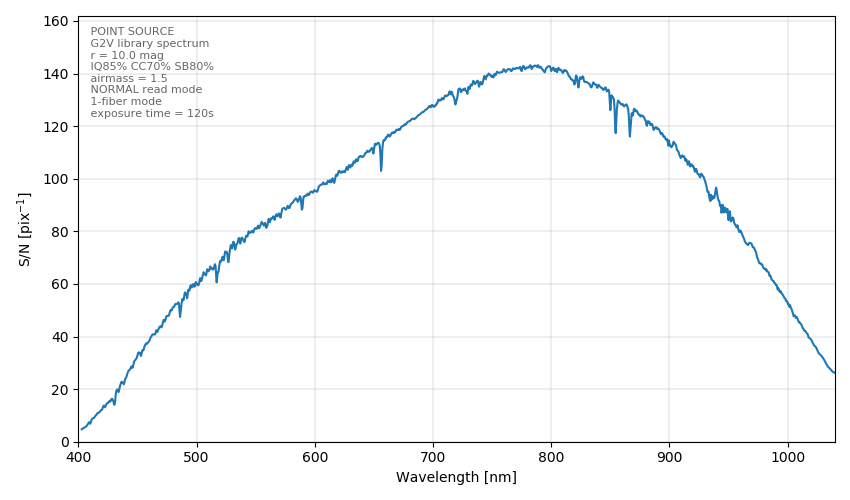Announcements
About
The GRACES Integration Time Calculator (ITC) can be used to determine limiting magnitudes, exposure times, S/N ratios, background levels, etc., for all the available GRACES configurations, any kind of observing conditions, and various types of targets.
The current ITC comes as both a Web form and Python script. The older, now deprecated, IDL script is still available, but for reference purposes only. Users are strongly encouraged to use current version as it is recalibrated, resolves many bugs identified in the IDL script, and provides several new features.
Python version
Setting up
Download GRACES_ITC_v2p1.zip to whichever location you like and unzip it. Beside the Python ITC script, the compressed folder contains the "filters" and "templates" folders, which are needed for the ITC script to run properly. Please do not rename these folders or modify their content. Before using ITC, ensure your computer meets the following requirements.
Requirements
- Python 3
- NumPy
- SciPy
- Matplotlib
How to use
In a terminal, cd to the location of the Python script, i.e. inside the unzipped folder. Then run the script from the terminal in one of the following ways:
python ITC.py
This runs the script without any parameters. The user is then asked step-by-step to interactively provide the required parameters.
python ITC.py -templ g2v -mag 10 -filter r -iq 85 -cc 70 -sb 80 -airmass 1.5 -rdmode normal -spmode 1 -exptime 120
This runs the script with some or all parameters. If any of the required parameters is missing or has an invalid value, the script will interactively ask the user to provide it. Note that there are also several optional parameters, such as a redshift or a number of exposures, which need to be provided directly when launching the script, otherwise the script will use their default values.
python ITC.py -h
This shows help and a list of all available parameters along with their potential default values.
What it does
Once the script has all the required parameters, it lists them in a terminal with the corresponding overheads, displays a plot of S/N vs. wavelength (see Fig. 1), saves it as a .png file, and its data as a .txt file. Users should copy-paste the list of selected parameters and overheads from the terminal, and the S/N plot to their observing proposal, along with any potential warnings that might get triggered, for example, if choosing longer than recommended exposure time, or if the selected parameters are expected to cause saturation.

Figure 1: An example S/N plot for a G2V star, produced by the ITC script.
The plot shows the S/N as a function of wavelength per physical pixel. If you instead wish to plot the S/N per optical resolution element, use the .txt file and multiply its S/N values by the square-root of the size of the optical resolution element in pixels, i.e. 1.74 pix for the 1-fiber mode and 2.88 pix for the 2-fiber mode. For the S/N per interpolated pixels, you need to multiply the curve from the .txt file by the square-root of 0.63, which is the spacing in pixels for each increment in wavelength in the extracted spectrum.
Important notes
When preparing a proposal using GRACES, PIs have to include overheads in their estimation of the total requested time for each target.
The central wavelength at which the guiding is optimized is assumed to be 700nm. If shorter central wavelength is selected, then the blue efficiency will be enhanced at the expense of the redder wavelengths due to the atmospheric differential refraction, and vice versa for the longer central wavelength. The differential refraction is stronger at higher airmasses and negligible near zenith.
Change log
- vBeta, 2015Sep18
- v1.0, 2015Sep22
- v1.1, 2016Feb08 - now can apply reddening to the template
- v1.2, 2016Apr21 - cuts the template spectrum between 350nm and 1250nm; the iterator for the loop creating the .dat file is now in format long
- v1.3, 2016Aug23 - gets rid of some of the output curves to avoid confusion in the ITC results
- v1.4, 2016Oct06 - fixes problems with M giant templates
- v2.0, 2020May20 - IDL code rewritten in Python; ITC recalibrated; several bug fixes; new features added
- v2.1, 2020Aug16 - UBVRI filter options added; refined photometric zeropoints for all filters; overheads added
Help
If you have any questions, comments, or need help with the GRACES ITC script, you are always welcome to contact the GRACES team.
Web form version
See above for more information on the output